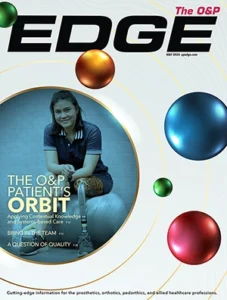Dear Mr Kwan,
Thank you for your response and interest.
I attended the Ispo meeting in Glasgow and while several projects in
developing countries were represented (ICRC for one), the conference covered
a broad range of topics and the vendors were primarily the same vendors seen
at major western technology meetings but in limited numbers
Unless the primary focus of the conference is appropriate technology for
developing countries, I don’t think it would cover the componentry and
techniques and work shops that would be highly useful for developing
countries.
I envision modern socket design and casting technique workshops by people
from the US and Europe and Mexico, presentations on modern surgical
techniques from leaders in the field, but also the display of componentry
from Alimco in India, feet made in Cambodia, components made in VietNam,
Jaipur feet, PVC pipe techniques for prostheses, knees and feet made by
smaller independent developers from India and other locations, ICRC systems,
Rothchilds light Pro system, Endoflex, and presentations by the numerous
foundations working in Central and South America, Africa, and Asia. If Asia
and Russia are producing cost effective componentry , that would be very
informative to know about.
I am on the very periphery of what is going on in these countries all over
the world, and I think if we hear from all the people working in these
countries, their input, needs, and willingness to share would be much more
valuable.
There is a new technology that is very appropriate for developing countries
that captures limb shape and creates models suitable for lamination out of
sand. This would be a prime type of “high tech” appropriate technology to be
shared.
Some ideas are very basic but useful such the idea that regular athletic
socks and nylon socks can be used in place of expensive prosthetic socks.
Sharing sources for plastic and pelite and laminating material is another
simple but important idea.
I envision the conference as a place where people could bring their problems
and see how others are solving those problems.
I would hope that others more intimately involved in these types of
situations would come forward and voice their opinions and suggestions.
Sincerely,
Mark Benveniste RN BS CP
In a message dated 1/16/2003 8:56:39 PM Central America Standard Tim,
[email protected] writes:
> Dear Mark,
>
> The 11th ISPO World Congress will be hosted in Hong Kong from 1-6 August
> 2004. As the heart of South East Asia, we are expecting a good presence
> from our neighbouring countries. We are at this moment consolidating the
> Scientific Programmes, we welcome and value all your contributions. Please
> give all your suggestions to our Scientific Programme Sub-Committee
> Chairman, Mr. David Boone at [email protected] and visit our web page
> http://www.polyu.edu.hk/ispo2004
>
> The coming Chinese New Year (1 Feb. 2003) is the Year of the Goat, may I
> take this opportunity to wish you all a prosperous year of the Goat.
>
> H H KWAN
> Secretary General
> Organizing Committee
> 11th ISPO World Congress
>
> If you have interest to know more about Hong Kong, please visit
> http://www.DiscoverHongKong.com
>
>
> —–Original Message—–
> From: Orthotics and Prosthetics List [mailto:[email protected]]On
> Behalf
> Of Benveniste, David Mark
> Sent: Friday, January 17, 2003 1:31 AM
> To: [email protected]
> Subject: Re: [OANDP-L] Components and techniques for developing countries
>
>
> I would personally like to see ISPO sponsor an AOPA/ACADEMY-type meeting in
> SE Asia that would
> display cost effective and “appropriate technology” techniques and
> componentry. This would provide a great way to share solutions, techniques,
> and sources for materials for all developing countries.
>
> I have been to Nepal and India, and hope to visit Cambodia and Thailand.
> The
> limited contact I have had with projects in these countries leads me to
> believe that it would be very beneficial for all developing countries to
> exchange solutions that have been developed locally.
>
> Prosthetics in the more affluent countries are too expensive for the most
> part to be practical.
> There are technologies in the US such as Rothchilds polypro socket/pylon
> foot system and the Endoflex system that might be appropriate in developing
> countries if give proper exposure.
>
> I think many components created in developing countries could also have a
> market here in the US as well.
>
> I think a major venue for the cross fertilization of ideas would be very
> useful.
>
> Is any organization or consortium of organizations such as ICRC and others,
> planning on such a meeting? Could ISPO take a role in creating this?
>
> Do prosthetists and orthotists in developing countries think this idea
> would
> benefit them?
>
> Mark Benveniste RN BS CP
> VA Medical Center
> Prosthetic Treatment Center
> Houston, TX
> USA
>




